支原体衣原体
advertisement
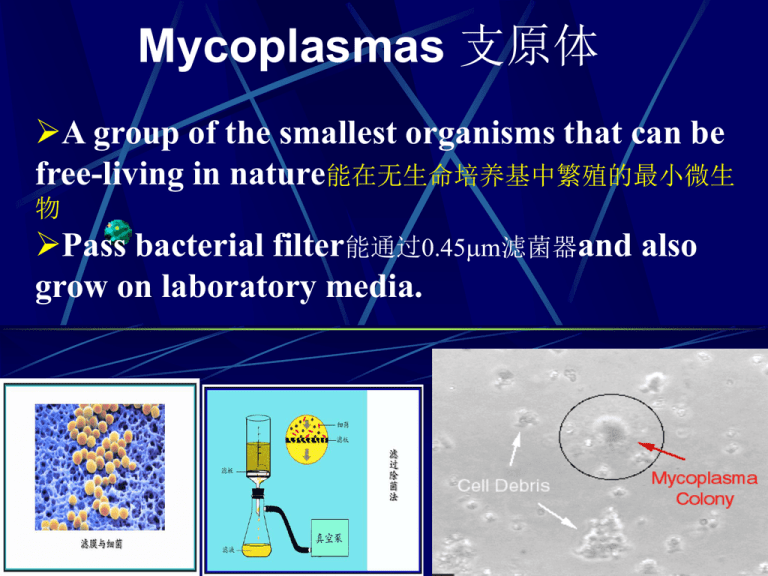
Mycoplasmas 支原体 A group of the smallest organisms that can be free-living in nature能在无生命培养基中繁殖的最小微生 物 Pass bacterial filter能通过0.45m滤菌器and also grow on laboratory media. Classification Mollicute柔膜体纲 Mycoplasmatales支原体目 Mycoplasmataceae Acholeplasmataceae Spiroplasmataceae 支原体科 支原体属 无胆甾原体科 脲原体属 Mycoplasma genera Ureplasma genera 螺原体科 生物学性状 没有细胞壁的原核细胞型微生物 多形性:球形,双球状,丝状, 特殊结构:荚膜,顶端结构,微丝 细胞膜含固醇 大小,0.2~0.3μm繁殖方式:二分裂繁殖,出芽等 含DNA与RNA 染色方法: Giemsa染色 淡紫色 革兰染色阴性 Mycoplasma and L Form Bacteria MYCOPLASMA L-FORM BACTERIA No genetic relationship with bacteria Relate to their parent bacteria ,sometimes can revert Cholesterol for their cell membrane No cholesterol for their cell membrane Stable in ordinary medium Need hyperosmotic solution Grow slowly, colony small (diameter 0.1-0.3mm) Colony larger(diameter 0.51.0mm) Low turbidity in liquid medium High turbidity in liquid medium ,may adhere to the wall or bottom of the tube 三、支原体与细菌L型的区别 支原体 在遗传上与细菌无关 细胞膜含高浓度固醇 在一般培养基中稳定 生长慢,菌落小, 液体培养混浊度极低 L型 与原菌相关,常可以回复 细胞膜不含固醇 大多需高渗培养 菌落稍大, 液体培养有一定混浊度 肺炎支原体 人型支原体 生殖器支原体 穿透支原体 溶脲脲原体 培养 营养要求 pH:低于7.0则死亡(溶脲脲原体 pH6.0~6.5) 生长缓慢 典型的菌落呈荷包蛋样 “T”株 液体培养基不易见到混浊 细胞培养污染的重要因素 Resistance Sensitive to osmotic pressure渗透压 resistant to thallium acetate醋酸亚 铊 in a concentration of 1:10000 which can inhibit bacteria 对青霉素等耐药 对干扰蛋白质合成抗生素敏感 Transmission M. pneumoniae is spread by close contact via aerosolized droplets and thus is most easily spread in confined populations (e.g., families, schools, army barracks). PATHOGENESIS Adherence factors - The P1 Adhesin localizes at tips of the bacterial cells and binds to sialic acid residues on host epithelial cells.The nature of the adhesins in the other species has not been established. Colonization of the respiratory tract by M. pneumoniae results in the cessation of ciliary movement. Toxic Metabolic Products Immunopathogenesis : most children are infected from 2 - 5 years of age but disease is most common in children 5-15 years of age. M.pneumoniae primary atypical pneumonia. Incubation: 1-3 weeks This disease can range from subclinical to bronchopneumonia, often with a gradual onset and mild to moderate severity. A long convalescence (4-6 weeks) and several possible complications (CNS, cardiac) follow acute disease. 主要致病性支原体 气管上皮纤毛 一、肺炎支原体 原发性非典型肺炎primary atypical pneumonia (间质性肺炎) 占非细菌性肺炎的二分之一 飞沫传播,夏末秋初为好发季节 症状较轻,发热、咳嗽、有时有呼吸道外并发 症 Clinical Findings U. urealyticum, M.hominis, M.genitalium are responsible for one form of nongonococcal urethritis. M. hominis is associated with pyelonephritis肾盂 肾炎, pelvic inflammatory disease 盆腔疾病. HOST DEFENSES Host defenses are not well characterized but probably involve both humoral and cell mediated responses. EPIDEMIOLOGY Mycoplasma affect a specific age distribution (5-9 year olds) and represent 8-15% of all pneumonias in school age children. Disease occurs worldwide, is endemic in some areas and is spread by close personal contact (schools, families). U. urealyticum is sexually acquired. Antibody titers in different age groups. Anti-mycoplasma pneumoniae antibodies indicate pneumonia caused by this organism is highest in the 5-15 year age group Acquired Pneumonia Caused by Mycoplasma pneumoniae Microbiological diagnosis Specimens: throat swab, sputum, genital secretion, etc. Microscopy - This is not particularly useful because of the absence of a cell wall but it can be helpful in eliminating other possible pathogens. Culture - Sputum (usually scant) or throat washings must be sent to the laboratory in special transport medium. It may take 2 -3 weeks to get a positive identification. Culture is essential for a definitive diagnosis. Complement fixation test Cold agglutinins - Approximately 34% - 68% of patients with M. pneumoniae infection develop cold agglutinins. ELISA - There is a new ELISA for IgM that has been used for diagnosis of acute infection. PCR 生长抑制试验(GIT) 代谢抑制试验(MIT) 血清抗体 CONTROL Sanitary: Avoidance of contacts, if possible. Immunological: No single vaccine is available. Natural resistance follows infection. Chemotherapeutic: Tetracycline, erythromycin or chloramphenicol are effective. 生化反应 人类主要支原体生物学性状 支原体 葡萄糖 精氨酸 尿素 致病性 肺炎支原体 + — — 肺炎、支气管炎 人型支原体 — + — 泌尿生殖道感染 生殖器支原体 + — — 泌尿生殖道感染 穿透支原体 + + — 溶脲脲原体 — — + 多见于艾滋病 泌尿生殖道感染 解脲支原体(M.urealyticum) 脲原体属中唯一的一个种,因生长 需要尿素而得名。分解尿素为其代 谢特征,产生氨氮,使培养基pH上 升,患者小便往往带有臊腥味。 菌落微小,直径仅有15~25um,须 在低倍显微镜下观察,称T株 (tiny strain)。 菌落表面有粗糙颗粒,在合适条件 下可转成典型的荷包蛋样菌落。 解脲支原体与女性生殖健康关系最为密 切,解脲支原体可引起泌尿生殖道感染, 并被认为是非淋球菌性尿道炎中仅次于 衣原体(占50%)的重要病原体。由于 80%孕妇的生殖道内带有解脲脲原体, 因此可通过胎盘感染胎儿而导致早产、 死胎,或在分娩时感染新生儿,引起呼 吸道感染。此外,解脲脲原体还可引起 不孕症。 解脲支原体感染 主要通过性生活传播,多见于年轻性旺盛时 期,尤多见于不洁性交后。 当泌尿生殖道发生炎症,粘膜表面受损时解脲 支原体易从破损口侵入,引起泌尿生殖道感 染。 患者大多无明显症状,也易造成医生漏诊。 解脲支原体可引起尿道炎、宫颈炎与前庭大腺 炎;上行感染时,可引起子宫内膜炎、盆腔 炎、输卵管炎,尤其输卵管炎多见。 致病性——形成细胞损伤 获得养料 产生有毒代谢产物 免疫损伤 三、穿透支原体 穿透支原体是1990年首次从1例HIV阳性艾 滋病患者尿中分离出的一种新支原体 穿透支原体的致病性与其尖形结构有关, 具粘附和穿入作用,引起细胞损伤 穿透支原体感染 是艾滋病的辅助致病因素 第一节 衣原体 衣原体(Chlamydia)是一类在真核细胞内寄生、有独 特发育周期、能通过滤菌器的原核细胞型微生物。 衣原体的特征是: ①严格的真核细胞内寄生,具有独特的发育周期,以二分裂 方式繁殖; ②革兰染色阴性,球形,也可呈椭圆形; ③具有与革兰阴性菌类似的细胞壁; ④含有核糖体,能进行多种代谢,因缺乏供代谢所需的能量 来源,故表现为严格的细胞内寄生; ⑤有DNA和RNA两种类型的核酸; ⑥对多种抗生素敏感,特别是对四环素和红霉素敏感。 发育周期 衣原体在宿主细胞内增殖,具有独特 的发育周期。用普通光学显微镜可观察到 两种大小、形态结构不同的颗粒。 原体(elementary body, EB) 始体(initial body) 原体:位于细胞外,球形,小而致密, 有感染性。 始体:位于细胞内,大而疏松,纤细网状 结构,也称网状体(reticulate body, RB), 无感染性。 衣原体分类 衣原体广泛寄生于人、哺乳动物及禽类体内,仅 少数有致病性。根据衣原体抗原构造、包涵体的 性质、DNA的同源性及对磺胺敏感性等的不同, 将衣原体属(Chlamydiae)分为四个种,即 沙眼衣原体(C. trachomatis) 沙眼生物亚种(Biovar trachoma)、 性病淋巴肉芽肿(Biovar lymphogranuloma venereum LGV)生物亚种和鼠生物亚种(Biovar mouse) 鹦鹉热衣原体(C. psittaci) 肺炎衣原体(C. pneumonia) 兽类衣原体(C. pecorum)。 主要 对人 致病 的衣 原体 沙眼 衣原 体最 多见。 致病性和免疫性 内毒素相似的致病物质。衣原体入侵在宿主细胞中大 量繁殖,抑制细胞代谢,致使细胞溶解; 衣原体尚可 引起超敏反应和形成肉芽肿。 主要的传播途径: 眼-眼、 眼-手-眼、 性接触传播 呼吸道感染。 所致主要疾病: 沙眼、 包涵体结膜炎、 泌尿生殖道感染、 性病淋巴肉芽肿和肺炎等。 Clinical manifestations of chlamydial infections 衣原体微生物学检查 1.直接涂片镜检 采用Giemsa、碘液或荧光抗体染色 镜检,检查细胞内有无包涵体。 2.分离衣原体 ,接种鸡胚卵黄囊或传代细胞。35℃ 培养48~72h。 3.衣原体抗原的检测,用免疫荧光法或酶标法检测衣 原体抗原。 4.血清学诊断 用于鹦鹉热衣原体和LGV的诊断。 5.多聚酶链反应(PCR)技术检测沙眼衣原体。 荧光抗体染色镜检 包涵体含糖原,被碘液染 为棕褐色 衣原体分离 采用感染组织的刮取物或分泌物,接种鸡胚卵 黄囊或传代细胞。衣原体培养较常用的是经放 线菌酮处理的单层McCoy细胞,或HeLa-229 细胞及BHK-21细胞,35℃培养48~72h。 核酸检测 肺炎衣原体 (chlamydia pneumoniae) 新发现的一种衣原体,主要引起呼吸道和肺部 感染。1986年Grayeton等在学生急性呼吸道 感染中,发现一种衣原体,以后于成人呼吸道 疾病中亦被发现,当时命名为鹦鹉热衣原体 TWAR-TW株,后经研究证明该衣原体为一新 种,并定名为肺炎衣原体。 psittacosis-ornithosis 鹦鹉热-鸟疫(psittacosis-ornithosis)是人 类、鸟类及一些哺乳动物均易感的自然 疫源性衣原体病,原是鸟类的特种传染病, 可传播于人,主要是由排菌鸟及其污染 物引起人类感染的,也是典型的动物源性 传染病。


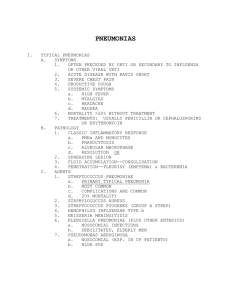
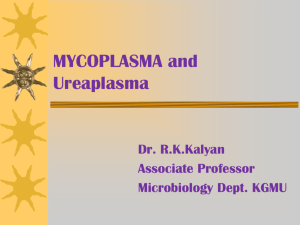
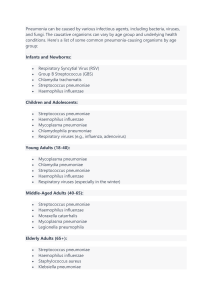

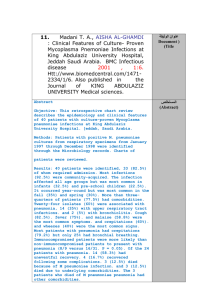
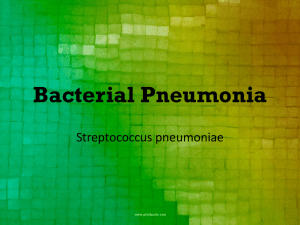
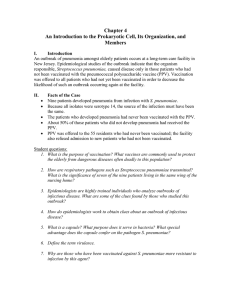
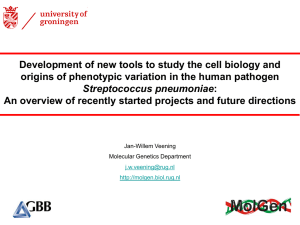
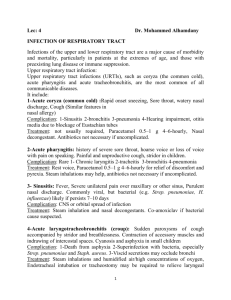
![2- Pneumonia I [Autosaved]](http://s3.studylib.net/store/data/009752027_1-098b5b19a0e3b878ffe76ff65cdcd01d-300x300.png)